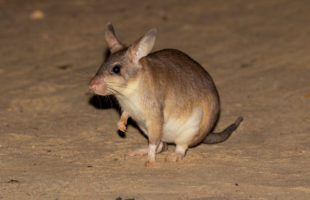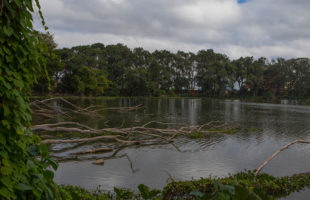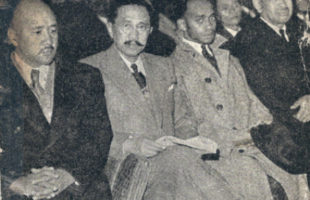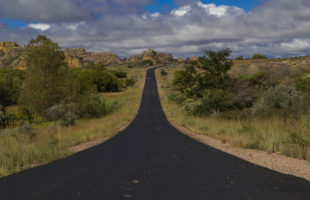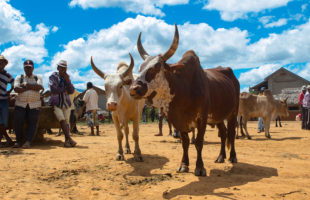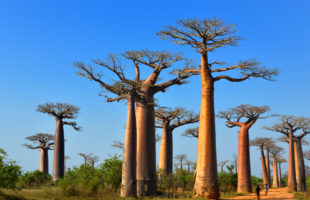Ihre Gesänge gehören zu den eindruckvollsten, die die Tierwelt zu bieten hat: Man kann die Stimmen der Indris (Indri indri) kilometerweit durch den Wald schallen hören, und sie tragen eine eigentümliche Traurigkeit mit sich. Angeführt und begonnen wird der Gesang stets vom Elternpaar einer Familie, das damit sein Revier absteckt, aber auch mit anderen Familien kommuniziert und vor Bedrohungen wie …
LesenMasika sipa
Der Tomatenfrosch
1875 fiel dem französischen Naturforscher Alfred Grandidier ein knallroter, dicker Frosch auf einer seiner vielen Reisen nach Madagaskar in die Hände. Gebracht hatte ihn ein Landsmann, der sich als Händler an der Ostküste niedergelassen hatte: Ein gewisser Herr Guinet. Der weit gereiste Grandidier nahm Tiere der noch unbekannten Art mit nach Frankreich und beschrieb sie dort erstmals. Warum ihm der …
LesenKirindy reserve
Kirindy: The word Kirindy means as much as „dense forest with wild animals“. Due to the more south located national park Kirindy-Mitea, the reserve is also known as “Kirindy Nord”. From former times it has the name “La forêt des Suisses”, the Swiss people’s forest. Location: Kirindy Forest is located in western Madagascar in Menabe region. From the capital of …
LesenPark Tsarasaotra
In the middle of Madagascar’s capital, Antananarivo, there is a small green oasis in the north of the town. It is known under its name Tsarasaotra (translated „a good place to live“) or simply „Ile aux oiseaux“ which means birds’ island. The area of 0,25 km² size includes lake Alarobia and a second smaller lake and some shore sides. The …
LesenThe second smallest reptile on Earth
It can sit on a matchstick without a problem, and you could almost think that the slightest breeze will blow the fragile pipsqueak off the match: Brookesia micra, the second smallest* reptile on Earth. Despite its few millimeters body lengths, the little, brown leaf chameleon has everything other chameleons need for life, too: Eyes moving to every possible direction, a …
LesenMadagascar’s fight for independence
In 1946, Madagascar became part of the official oversea areas of France and thus part of this state. At that time, about 35.000 French people already lived in Madagascar. In the same year, the party “Mouvement démocratique de la rénovation malgache” (MDRM) was founded. This party advocated for Madagascar as an independent country inside the French Union and supported the …
LesenStreets and bridges
As you already know from many tropical countries, many of Madagascar’s streets are rather sandy pathways or muddy tracks than drivable roads. More than 90% of the streets are not paved, which makes travelling time-consuming, especially since distances between national parks or other things worth seeing are mostly very far. Generally, a small network of larger streets leads across the …
LesenMadagascar’s secret emblem: The zebu
It is Madagascar’s secret emblem: The zebu (Bos taurus indicus), in Malagasy language omby. You can see them everywhere around the country, about 19 millions live on the red soil of the island. In Madagascar, zebus symbolize power, strength and particularly prosperity. An average zebu tips the scales at 300 to 400 kg – at an shoulder height of approximately …
LesenThe Tropic of Capricorn
If you drive the RN10 in Madagascar from Toliara (Tuléar) to Anakao, you will somewhen pass a white sign besides the red sandy slope. The same sign stays near Befasy, a little more east in the country – but there is even no slope to drive on with a vehicle. The sign shows the symbol of a capricorn with a …
LesenThe country of Baobabs
What would Madagascar be without its giant landmarks, the mighty baobabs? Over here, they might be known as monkey bread, and have been famous as photo motives and in literatures for centuries. These huge trees, whose roots seems to grow into the sky, enchant everyone, and many baobabs are told to possess magic power. Madagascar has not less than seven …
Lesen MADAMAGAZINE Your Magazine about Madagascar
MADAMAGAZINE Your Magazine about Madagascar



